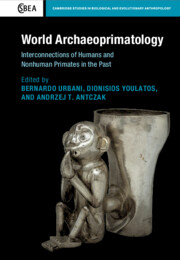Book contents
- World Archaeoprimatology
- Cambridge Studies in Biological and Evolutionary Anthropology
- World Archaeoprimatology
- Copyright page
- Dedication
- Contents
- Contributors
- Foreword
- Acknowledgments
- World Archaeoprimatology
- Part I The Americas
- 1 Monkeys in the City of Gods
- 2 Monkeys and the Ancient Maya
- 3 Monkeys on the Islands and Coasts of Paradise
- 4 Mirroring Desert Societies with Monkeys
- 5 Alterity, Authority, and Ancestors
- 6 Representations of Primates in Petroglyphs of the Brazilian Amazonia
- 7 Nonhuman Primates in the Archaeological Record of Northeastern Brazil
- 8 Lice in Howler Monkeys and the Ancient Americas
- Part II Europe
- Part III Africa
- Part IV Asia
- Index
- References
3 - Monkeys on the Islands and Coasts of Paradise
Pre-Hispanic Nonhuman Primates in the Circum-Caribbean Region (300–1500 CE)
from Part I - The Americas
Published online by Cambridge University Press: 03 August 2022
- World Archaeoprimatology
- Cambridge Studies in Biological and Evolutionary Anthropology
- World Archaeoprimatology
- Copyright page
- Dedication
- Contents
- Contributors
- Foreword
- Acknowledgments
- World Archaeoprimatology
- Part I The Americas
- 1 Monkeys in the City of Gods
- 2 Monkeys and the Ancient Maya
- 3 Monkeys on the Islands and Coasts of Paradise
- 4 Mirroring Desert Societies with Monkeys
- 5 Alterity, Authority, and Ancestors
- 6 Representations of Primates in Petroglyphs of the Brazilian Amazonia
- 7 Nonhuman Primates in the Archaeological Record of Northeastern Brazil
- 8 Lice in Howler Monkeys and the Ancient Americas
- Part II Europe
- Part III Africa
- Part IV Asia
- Index
- References
Summary
This chapter presents a comprehensive review of the interaction between circum-Caribbean indigenous peoples and nonhuman primates before and at early European contact. It fills significant gaps in contemporary scholarly literature by providing an updated archaeological history of the social and symbolic roles of monkeys in this region. We begin by describing the zooarchaeological record of primates in the insular and coastal circum-Caribbean Ceramic period archaeological sites. Drawing from the latest archaeological investigations that use novel methods and techniques, we also review other biological evidence of the presence of monkeys. In addition, we compile a list of indigenously crafted portable material imagery and review rock art that allegedly depicts primates in the Caribbean. Our investigation is supplemented by the inclusion of written documentary sources, specifically, ethnoprimatological information derived from early ethnohistorical sources on the multifarious interactions between humans and monkeys in early colonial societies. Finally, we illustrate certain patterns that may have characterized interactions between humans and monkeys in past societies of the circum-Caribbean region (300–1500 CE), opening avenues for future investigations of this topic.
Archaeoprimatology, Ceramic period, Greater and Lesser Antilles, Island and coastal archaeology, Saladoid, Taíno, Trinidad, Venezuela
- Type
- Chapter
- Information
- World ArchaeoprimatologyInterconnections of Humans and Nonhuman Primates in the Past, pp. 63 - 107Publisher: Cambridge University PressPrint publication year: 2022
References
- 1
- Cited by



